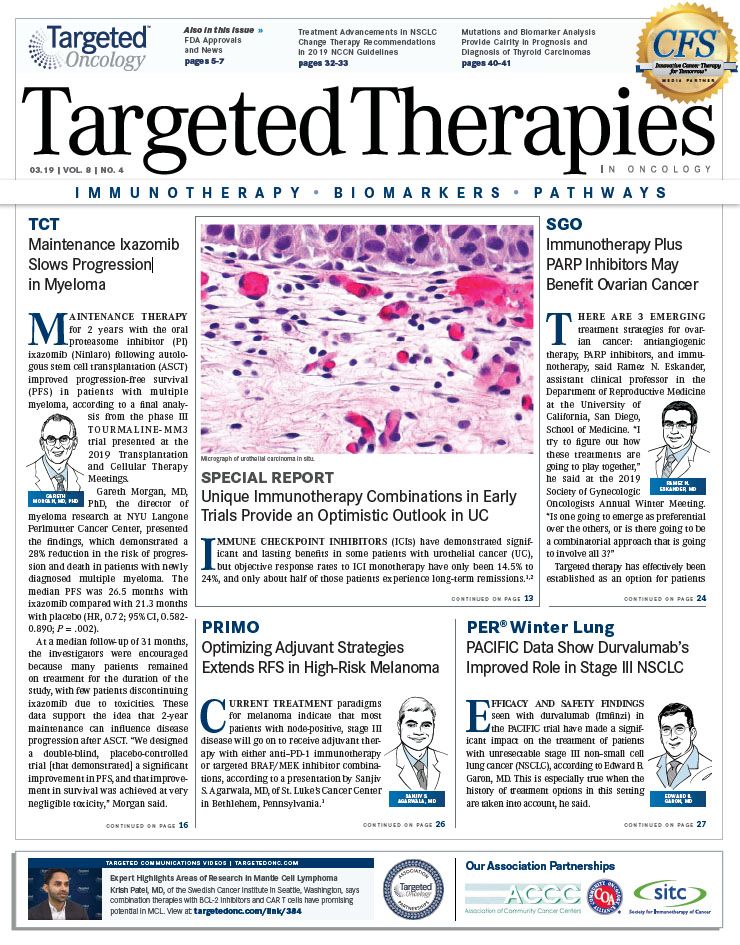Recognizing Endometrial Tumor Immune Features Is Key to Treatment Success
Identifying the inflamed tumors that are most likely to respond favorably to immunotherapeutics and, conversely, finding ways to treat noninflamed tumors are essential for successful application of immunotherapy in endometrial cancer, according to a presentation at the 2019 Society of Gynecologic Oncology Annual Winter Meeting.
Kathleen Moore, MD
Identifying the inflamed tumors that are most likely to respond favorably to immunotherapeutics and, conversely, finding ways to treat noninflamed tumors are essential for successful application of immunotherapy in endometrial cancer, said Kathleen Moore, MD, at t in Olympic Valley, California.1
Inflamed tumors, she said, include polymerase-ε (POLE)- mutated or microsatellite instability (MSI)-high tumors, that the immune system can recognize and kill. However, the process is more complicated than that.
“If that worked, we would not have cancer at all. It would be something that was always taken care of by our innate surveillance systems,” said Moore, associate director for clinical research and director of the Oklahoma TSET Phase I Clinical Trials Program for the Stephenson Cancer Center at the University of Oklahoma in Oklahoma City. She is also the director of Gynecologic Oncology Fellowship at the University of Oklahoma Health Sciences Center.
“There are so many different elements that contribute to what we call the individual’s cancer-immune set point,” she told attendees. “This is where the personalization of medicine comes in and explains why some people do [or] do not respond to immunotherapy.”
Moore said there are preclinical data suggesting that these “hot” tumors are susceptible to immunotherapy. These tumors express increased infiltration with CD8-positive T cells in both the tumor and the surrounding stroma. Further, these tumors display a high preponderance of genes involved with T-cellmediated toxicity such as TIM3 and LAG3. Moore added that these patients carry a high tumor burden and express a high number of neoantigens, which should mean they are primed to respond to immunotherapy.
“Additionally, tumors with POLE and MSI also make these things called tertiary lymphoid structures,” Moore said. “They are so inflamed and there are so many immune cells infiltrating the tumors, they actually try to create new lymph nodes in the tumor.”
The 2017 approval of pembrolizumab (Keytruda) as a tumor-agnostic treatment for MSI-high or mismatch repair (MMR) deficient tumors further suggests that these tumors may respond to immunotherapy, she added.
Some receptors, such as TIM3 and LAG3, inhibit the T cells while others, such as CD28 and OX40, enhance T-cell activation. Investigators are exploring the possibility of targeting one such receptor in a phase I study (NCT03538028) of INCAGN02385, an antagonist antibody targeting LAG3 for the treatment of several MSI-high advanced malignancies that have progressed following treatment.
“LAG3 alone may not be the right thing. We may have to use it in combination or maybe we have to use it from the beginning,” Moore said. “We are in our infancy of our understanding of how to use these drugs, but they are already in clinical trials in endometrial cancer.”
For immune-excluded, or “cold,” tumorsthose where the immune system is activated but its components cannot get into the tumor—Moore said it may be possible to treat those with vascular endothelial growth factor (VEGF)-inhibitors by boosting T-cell priming with chemotherapy. “VEGF is a highly immunosuppressive molecule. It is not just an angiogenic molecule,” she said. “It directly inhibits T-cell function, and it inhibits T-cell trafficking to the tumor, which is why it is of interest in these immune-excluded tumors.
“There is a great deal of data in other tumors, renal cell [carcinoma] being the key, showing that if you combine immune therapy with antiangiogenic agents like bevacizumab [Avastin], you improve the infiltration of previously excluded T cells into the tumor.”
Vicky Makker, MD, et al evaluated the combination of the multikinase VEGF inhibitor lenvatinib (Lenvima) plus pembrolizumab to treat patients with advanced endometrial cancer (NCT02501096). Patients with histologically confirmed disease irrespective of MSI or MMR status were assigned to 20 mg of daily lenvatinib plus 200 mg of pembrolizumab every 3 weeks.
In results presented at the 2018 American Society of Clinical Oncology Annual Meeting, Makker et al found that the combination induced an objective response rate (ORR) of 39.6% (95% CI, 26.5%-54.0%) by independent investigator review and the duration of response had not yet been reached (range, 7.4 months-not estimable [NE]). The ORR was 50.0% (95% CI, 6.8%-93.2%) among the MSI-high subset (n = 4). The median progression-free survival (PFS) was 7.4 months (95% CI, 5.0-NE).2
Moore said the ORR for patients with recurrent disease is typically about 15%, with a PFS of 3 months. “This is really an outlier when you think about data that [have] been presented in endometrial cancer,” she said.
Moore said that future research efforts should focus on understanding why patients in the inflamed subgroup fail to respond to immunotherapy, understanding why patients develop resistances and how to overcome those resistances. Additionally, more should be done to identify all patients in the inflamed subgroup, not just those with MSI-high status, so that these patients can receive immune checkpoint inhibitors.
“There is room for improvement there,” Moore concluded. “We have already shown it with lenvatinib and pembrolizumab, so I think there is reason to be very optimistic.”
References:
- Moore K. Immuno-oncology for endometrial cancer: therapeutic implications. Presented at: 2019 Society of Gynecologic Oncology Annual Winter Meeting; January 17-19, 2019; Olympic Valley, CA.
- Makker V, Rasco DW, Vogelzang NJ, et al. Lenvatinib + pembrolizumab in patients with advanced endometrial cancer: updated results. J Clin Oncol. 2018;36(suppl 15; abstr 5596). ascopubs.org/doi/abs/10.1200/JCO.2018.36.15_suppl.5596.
